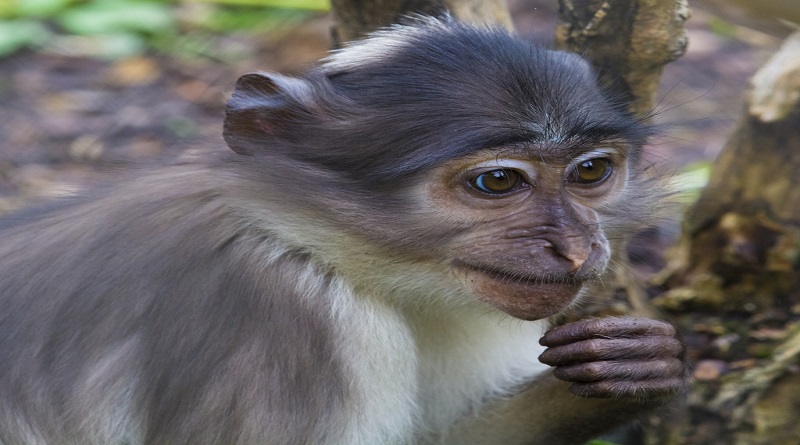White-naped Mangabey, IUCN Red List Species found in Atewa Forest-Ghana
Scientists have discovered the globally threatened White-naped Mangabey (Cercocebus lunulatus) in Ghana’s Atewa Forest. The mangabey – a rare terrestrial monkey – is classified as Critically Endangered on the IUCN Redlist of Threatened Species. The primate was known to live in only a handful of sites in western Ghana, eastern Cote d’Ivoire and southern Burkina Faso, but was recently discovered by A Rocha scientists in the Atewa Forest using camera traps.
“Unfortunately, this newly discovered population of this endangered monkey in Atewa is threatened by a bauxite mine being planned for this biologically important forest, as well as by snare traps and hunting for the bush-meat trade”, says Dr Jeremy Lindsell of A Rocha International who led the survey.
Andrea Dempsey, the Executive Director for West African Primate Conservation Action (WAPCA) which supports a captive breeding programme for White-naped Mangabeys in Accra and Kumasi zoos says: “White-naped Mangabeys are so rare that I think these may be the first photographs of them in the wild in Ghana. Finding them in Atewa Forest gives hope to our efforts to save them. Protecting critical habitat such as Atewa Forest will be key for their long term survival.” Atewa Forest harbours a high diversity of threatened and endemic species including birds, mammals, reptiles, butterflies and amphibians. In recent months, the high economic value of the ecosystem services that Atewa Forest provides to many Ghanaians was highlighted in a 2016 report to the Government of Ghana titled The Economics of the Atewa Forest Range, Ghana. Chief amongst these services is the clean water supply flowing from the Atewa hills on which over five million Ghanaians depend.
This makes it all the more concerning that the Government of Ghana with the Government of China wants to push ahead with plans to extract bauxite – the ore of aluminium – from the Atewa Hills at Kyebi. The hill tops of Atewa will be completely removed during mining because the bauxite deposits are only found in the top few metres. This will destroy all vegetation and associated fauna because bauxite cannot be extracted using a low impact method. Re-establishment of the original flora and fauna on areas that have once been mined is virtually impossible especially with highly complex and biologically rich forests like Atewa.
“Extracting bauxite from Atewa Forest is incompatible with biodiversity conservation and the ecosystem services that the forest provides. It will spell the end of the unique and irreplaceable species that the forest contains,” says Jan Kamstra of the International Union for Conservation of Nature (IUCN) Netherlands. A Rocha, IUCN Netherlands and many other stakeholders including international businesses have advocated for Atewa Forest reserve to be upgraded to a National Park. The creation of a new National Park at Atewa has substantial local support, including from the Okyenhene of Akyem Abuakwa Traditional Area, where the forest is located.
In a letter to the President of Ghana dated 15th December, Dr Russ Mittermeier, Chair of the IUCN Primate Specialist Group, writes: “It is a matter of some urgency that the forest is properly protected both from hunting and from habitat change… I urge that Ghana’s commitments to the Convention on Biological Diversity and to the Sustainable Development Goals take precedence in this case and that Atewa Forest is removed from mining plans once and for all and made into a National Park.”
Mr Seth Appiah-Kubi, Director of A Rocha Ghana said “The discovery of this Mangabey confirms that there is more in Atewa Forest that we are yet to discover, but mined today it will be lost forever. The threat of destruction has hung over Atewa Forest for too many years now, so it is time for the Government of Ghana to stand by its commitments to a sustainable future for our people, to honour first of all his commitment to securing our natural heritage, and also our international commitments, and to act to protect this forest in perpetuity as a National Park. It would be appalling to see a decision taken that would push so many species that much closer to extinction.”




